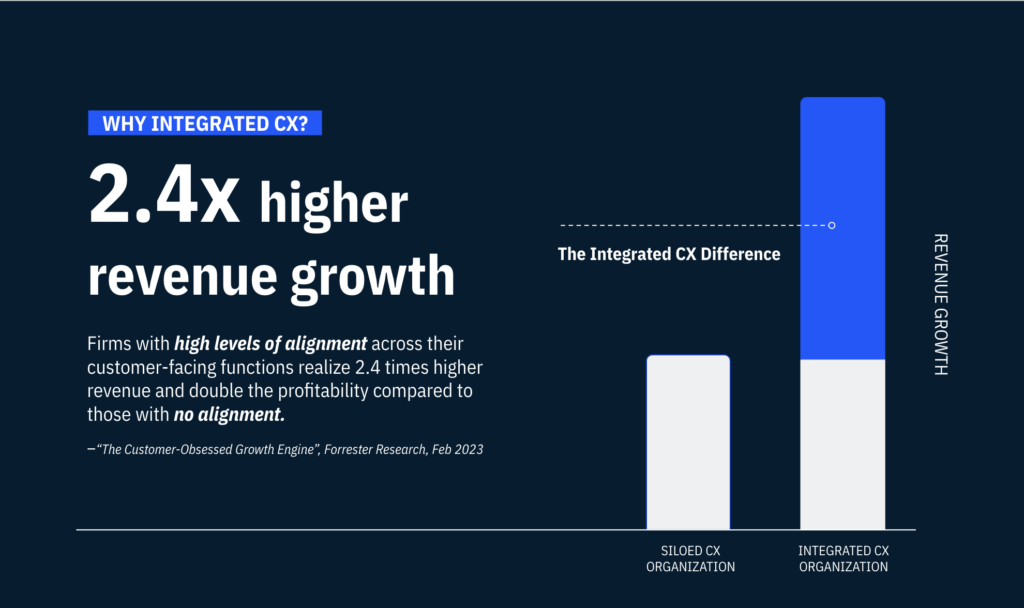Calculating the return on investment (ROI) of customer experience (CX) initiatives is extremely important; it’s a way for businesses to find out if their current customer service strategies are working, as well as for CX leaders to be able to justify the budget and resources they’ve used on those initiatives.
However, measuring customer experience ROI can be tricky as there isn’t a one-size-fits-all metric that covers all stages of the customer journey. This article will explore the five key metrics used to assess the ROI of customer experience initiatives and provide strategies for effectively utilizing them.
1. Revenue Growth
A company’s top-line revenue growth is one of the most precise CX ROI metric that can be reviewed. A Forrester study found that companies focusing on CX experience 41% higher revenue growth, 49% faster profit increase, and 51% improved retention rates.
The results of the study are not surprising, knowing that great customer experience has a tremendous ripple effect. When customers are happy, they not only stay with a company but also act as its advocates, spreading the word about their positive experience and effectively bringing new customers on board. Unhappy customers, on the other hand, can wreak havoc on a company financially. Not only do unhappy customers leave, but they also act as detractors by flooding review sites and social media pages with negative ratings and reviews.

2. Customer Experience Survey Scores
Customer experience surveys help companies convert customer feedback into quantitative data to measure the efficacy of their CX strategies and, by extension, their ROI. The following are some of the most popular surveys for measuring customer experience:
- Customer Satisfaction (CSAT) surveys: deployed to help businesses understand and measure how satisfied customers are with their products and/or services.

- Net Promoter Score (NPS) surveys: deployed to help businesses measure customer loyalty and predict business growth.

- Customer Effort Score (CES) surveys: deployed to help businesses identify roadblocks and any factors that can cause customers to exert more effort than usual and be frustrated with your products and/or services.

3. Cross-selling and Upselling Rates
Happy and loyal customers buy additional products or services from a company, accounting for a remarkable increase in its revenue. Several studies have confirmed this, including the following:
- According to the book Marketing Metrics, businesses have a 60–70% chance of selling to existing customers, as opposed to selling to a new prospect, which has a likelihood of only 5–20%.
- Research has shown that even a mere 5% increase in customer retention can increase a company’s profit between 25-95%.
4. Customer Retention and Churn Rates
Another important metric for businesses to find out if their CX investments are paying off is by monitoring customer churn rates. Businesses can measure their churn rate by calculating the number of customers who have stopped buying their products and/or unsubscribed from their services over a given period of time.
According to a recent study from SAP, 52% of customers have switched from a brand they were loyal to due to a bad experience.

5. Cost of Customer Support
Good customer experience plays a significant part in reducing customer support costs. The more happy customers you have, the fewer complaints and tickets your team is going to receive and deal with.
Other CX improving measures, such as providing customers with self-service options, also contribute to the reduction of customer service costs. A Harvard Business Review study shows that 81% of customers prefer self-service due to the convenience of finding the answers they need online at any time, without needing to contact your customer support representatives during business hours. When over 80% of your customers can self-serve, you’ll see a dramatic decrease in your ticket volume and, by extension, cost of service.
Final Thoughts
You can’t manage what you can’t measure. In order for you to continue running customer experience programs, it’s important that you understand whether they’re working in the first place and how much they’re contributing to your organization’s bottom line. While each CX program is different, the above metrics can help put a dollar value on most of your initiatives.
Moreover, there are several customer experience management solutions that can help you deploy customer experience initiatives and measure their effectiveness. If you are in the market for one, check out our detailed review of the best customer relationship management (CRM) solutions to make the right decision.



























